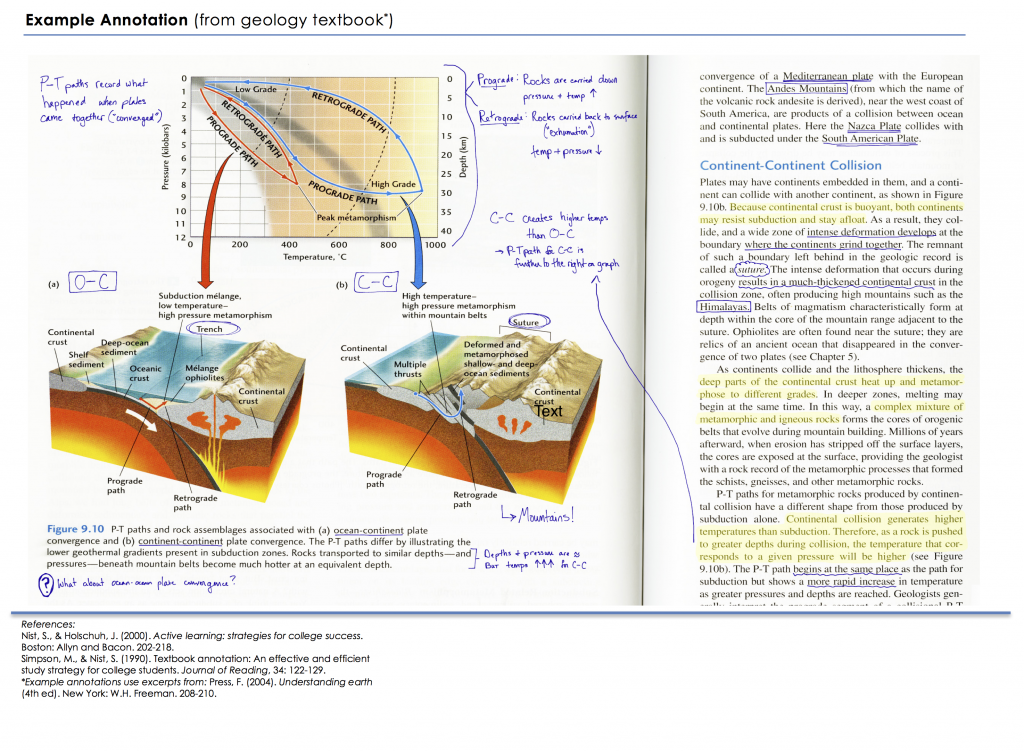Annotating Texts
What is annotation?
Annotation can be:
- A systematic summary of the text that you create within the document
- A key tool for close reading that helps you uncover patterns, notice important words, and identify main points
- An active learning strategy that improves comprehension and retention of information
Why annotate?
- Isolate and organize important material
- Identify key concepts
- Monitor your learning as you read
- Make exam prep effective and streamlined
- Can be more efficient than creating a separate set of reading notes
How do you annotate?
Summarize Key Points in Your Own Words
- Use headers and words in bold to guide you
- Look for main ideas, arguments, and points of evidence
- Notice how the text organizes itself. Chronological order? Idea trees? etc.
Circle Key Concepts and Phrases
- What words would it be helpful to look-up at the end?
- What terms show up in lecture? When are different words used for similar concepts? Why?
Write Brief Comments and Questions in the Margins
- Be as specific or broad as you would like—use these questions to activate your thinking about the content
- See the guide on reading comprehension tips for some examples
Use Abbreviations and Symbols
- Try ? when you have a question or something you need to explore further
- Try ! When something is interesting, a connection, or otherwise worthy of note
- Try * For anything that you might use as an example or evidence when you use this information.
- Ask yourself what other system of symbols would make sense to you.
Highlight/Underline
- Highlight or underline, but mindfully. Check out the resource on strategic highlighting for tips on when and how to highlight.
Use Comment and Highlight Features Built into PDFs, Online/Digital Textbooks, or Other Apps and Browser Add-ons
- Are you using a pdf? Explore its highlight, edit, and comment functions to support your annotations
- Some browsers have add-ons or extensions that allow you to annotate web pages or web-based documents
- Does your digital or online textbook come with an annotation feature?
- Can your digital text be imported into a note-taking tool like OneNote, EverNote, or Google Keep? If so, you might be able to annotate texts in those apps
What are the most important takeaways?
- Annotation is about increasing your engagement with a text
- Increased engagement, where you think about and process the material then expand on your learning, is how you achieve mastery in a subject
- As you annotate a text, ask yourself: "How would I explain this to a friend?"
- Put things in your own words and draw connections to what you know and wonder
The table below demonstrates this process using a geography textbook excerpt (Press 2004):
| Passage from Text | Too Much Writing | Not Enough | Good Balance |
|---|---|---|---|
| "The shape of metamorphic P-T paths provides insight into the manner in which these rocks are metamorphosed. In convergent margin settings, P-T paths indicate rapid subduction of rocks and sediments to sites with high pressures and relatively low temperatures. In settings where subduction leads to continental collision, rocks are pushed down to depths where pressure and temperature are both high. In both settings, the P-T paths form loops. These loops show that after the rocks experienced the maximum pressures and temperatures, they were pushed back up to shallow depths." |
Shape of P-T paths tells us about the conditions of metamorphosis:Convergent margin settings: rocks are subducted to depths with high temperature and low pressure - Continental collision settings: rocks are subducte to depths with high temperature and high pressure.- Continental collision settings: rocks are subducted to depths with high temperature and high pressure In both cases, the P-T paths form loops, showing that the rocks were pushed back up. |
P-T paths show conditions
Two settings
P-T paths loop |
Shape of P-T paths reveals subduction site depths, temps, pressure Settings:
P-T paths loop in both settings |

A common concern about annotating texts: It takes time!
Yes, it can, but that time isn’t lost—it’s invested.
Spending the time to annotate on the front end does two important things:
- It saves you time later when you’re studying. Your annotated notes will help speed up exam prep, because you can review critical concepts quickly and efficiently.
- It increases the likelihood that you will retain the information after the course is completed. This is especially important when you are supplying the building blocks of your mind and future career.
One last tip: Try separating the reading and annotating processes! Quickly read through a section of the text first, then go back and annotate.
Works Consulted
Nist, S., & Holschuh, J. (2000). Active learning: strategies for college success. Boston: Allyn and Bacon. 202-218.
Simpson, M., & Nist, S. (1990). Textbook annotation: An effective and efficient study strategy for college students. Journal of Reading, 34: 122-129.
Press, F. (2004). Understanding earth (4th ed). New York: W.H. Freeman. 208-210.
Developed and shared by The Learning Center, University of North Carolina at Chapel Hill.